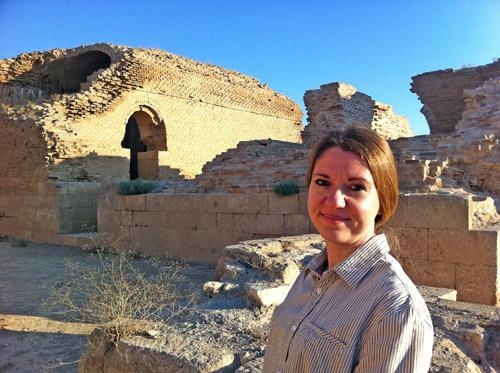You are here
Multidisciplinary approach to archaeology improves research findings — Jordanian expert
By Saeb Rawashdeh - Jul 16,2017 - Last updated at Jul 16,2017

Catreena Hamarneh
AMMAN — “Archaeology has moved forward from a standalone scientific approach to a multidisciplinary approach, where archaeology intertwines with other sciences,” noted Catreena Hamarneh, a Jordanian archaeologist working at the German Protestant Institute of Archaeology in Amman.
“This approach helps to reconstruct and better understand past civilisations and conditions that prevailed and dictated their decisions,” she continued.
With her background in geology and archaeology, Hamarneh has worked at different sites in Jordan including Madaba, Jerash, Qasr Mushatta and, more recently, in Petra.
“In 2010, Professor Johannes Cramer from Technische Universitat Berlin, who was heading the Mushatta Conservation Project at the time, approached me asking about my expertise in studying a hoard of mosaic tesserae, which was found during our work at the site. This discovery was quite exciting although not unique,” she said.
Mushatta, a desert palace and mosque built during the reign of caliph Al Walid II (743-744 AD), around 30km south of Amman, is known for its carved façade, which is displayed at the Pergamon Museum in Berlin, Hamarneh explained, adding that the palace construction was abruptly terminated. There is a dispute amongst archaeologist on whether it was partially occupied or not, she noted.
“The discovery of stone and glass tesserae [cut cubes] informs us of the fact that there had been mosaic decoration at the site, but, with archaeometry, our knowledge expands,” the scholar stressed.
With the petrographic analysis and scanning electron microscope, among others, several facts have been established, the archaeologist said.
“Comparing the remnants of mortar [the adhesive material] found on the tesserae with those remaining at different architecture parts of the palace, I have managed to establish that these tesserae had once covered the palace walls,” Hamarneh explained.
“With archaeometry, we learned that the stone supply was local, she underlined, adding “this could even indicate that the artist labouring at the site could have been a local artist, which means that the Umayyads encouraged local artisans and recruited them on constant bases.”
Although Jordan has very well-established scientific institutions, a lot of analysis still needs to be outsourced, she said, noting that scientific funds are mainly restricted to scientist and academics working at Jordanian institutions, therefore excluding a group of independent Jordanian scholars, students and postgraduates who are deprived of funding. Hamarneh described this trend as “unfortunate”, as it could enrich the scientific research in Jordan.
Currently, Hamarneh’s research is focused on landscape archaeology, studying ancient terraces in the hinterlands of Petra.
“In 2015, my research took me to landscape archaeology. Benefiting from my joint background in geology and archaeology, I joined a team of researchers that worked on studying the role of ancient terraces in modifying surface run-off,” the expert pointed out.
Although this project had finished in 2016, it raised her interest in ancient dry stone terraces which she now devotes her time to.
“My research is concentrated in the hinterlands of Petra, focusing on understanding the various functions of terraces, their methods of construction, their origins and period of use,” Hamarneh highlighted.
Although her research is only in its beginning, with most of the data and analysis currently being processed abroad, she said “it is opening a whole new world about resource management of the ancient settlers and the modifications they have made to the city’s morphology and the environment”.
“The aim of the research is not only to understand these ancient technologies, but also to revive them as climatic conditions are starting to resemble the dry climate of the past, which our ancestors not only managed to surpass, but also turn into a green paradise that astonished caravans,” the archaeologist noted.
Related Articles
AMMAN — The “Restoration of the Ancient Nabataean Flood Control System in Wadi Madras at Petra” project has won the Arab Forum for Cultural
AMMAN — The study of modern society and modern people can help answer archaeological questions, according to British scholar Sarah Elliott.“
AMMAN — A workshop titled "Ancient Terraces Practices in Jordan", was held on Sunday at the German-Jordanian

















